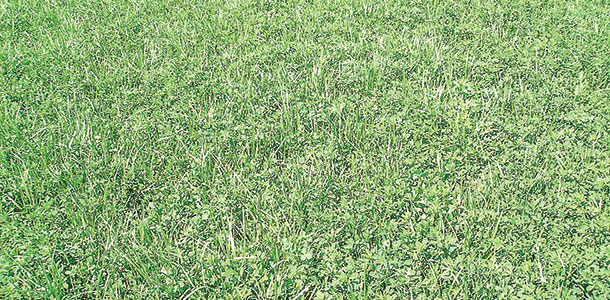A survey of New York cooperative extension educators estimated that 80 percent of the alfalfa seeded in that state included a grass, while in the Midwest the percentage is much less, and in the arid Southwest and West it’s very low.
The trend on dairy farms, however, is toward seeding alfalfa with a cool-season grass such as orchardgrass or tall fescue. Research has shown that not only does alfalfa-grass result in higher yields, but in areas with “real” winters, the insulating effect of the grass will protect the alfalfa plants. But the best reason to consider alfalfa-grass is the potential for higher milk production, both per acre and per ton.
Alfalfa-grass and milk response
The potential for higher milk production was shown in the results of recent University of Minnesota trial where alfalfa was seeded alone versus in combination with several cool-season forage grasses.
Both alfalfa-orchardgrass and alfalfa-tall fescue yielded 7 percent more than did straight alfalfa. More importantly, however, the improvement in forage quality indicated that both alfalfa-grass mixtures would result in more milk per ton and per acre.
These results are consistent with those of a lactation trial at the University of Wisconsin. In this research, a forage ration of 50 percent alfalfa and 50 percent corn silage was compared to a ration composed of equal percentages of alfalfa, corn silage and tall fescue.
Dairy cows in the trial consumed the same amount of dry matter of both rations, but those on the three-way mixture produced 5 pounds more milk per cow. Therefore, alfalfa-grass has advantages both in the field and in the feedbunk, a fact increasingly being recognized by farmers and dairy nutrition consultants.
However, the forage grass species mentioned in these trials aren’t the ones your grandfather grew. (If indeed he grew grass at all.) In the Minnesota trial, the agronomists also included the old standby timothy, which (in the Northeast at least) is still a very popular species.
The alfalfa-timothy mixture yielded much less than did straight alfalfa, alfalfa-orchardgrass and alfalfa-tall fescue.
And while milk per ton was higher versus straight alfalfa, the low yield of alfalfa-timothy resulted in 8 percent less milk per acre. This may be because timothy often doesn’t yield much after the soil warms up in early summer, which is why an alfalfa-timothy field in late May looks a lot like an alfalfa field by the time July rolls around.
That’s why I call timothy the “schoolteacher’s grass” – because it works hard through May and then takes the summer off. (My schoolteacher friends don’t much appreciate this comment, but farmers seem to.)
Now that plant breeders have developed varieties of tall fescue that are endophyte-free, it’s the species I prefer for alfalfa-grass seedings, especially on fields with variable drainage.
Tall fescue is an aggressive species, so it’s wise to keep the seeding rate on the modest side. Refer to your state university guidelines for seeding rates, but a 3-to-1 ratio of alfalfa to tall fescue seems about right, with a total of 15 to 20 pounds of seed per acre depending on soil conditions.
Orchardgrass may be preferred by top-notch managers on well-drained soils, but it’s more susceptible to winterkill, especially ice-sheet damage. As with tall fescue, keep the orchardgrass seeding rate modest.
One year we seeded only 1 pound of orchardgrass with 14 pounds of alfalfa, and it appeared that every orchardgrass seed must have germinated and produced a plant. And if you plant orchardgrass with alfalfa, buy the very latest-maturing variety of orchardgrass you can find.
Check soil test K status before you seed
The grass in an alfalfa-grass seeding is often called a “companion crop,” but where the soil potassium level is limiting it’s not a companion but a competitor – and a very tough one at that.
Alfalfa has taproots that extract nutrients from a soil depth of 5 feet or more. Cool-season grasses have a fine, fibrous root system that will penetrate about 2 feet. It doesn’t take long for this root system to develop.
Here’s an old textbook description of root growth for a spring seeding of orchardgrass: “By August 26, the tufts or bunches of grass were provided with roots which literally filled the surface soil with great masses of tan-colored fibrous roots to a depth of nearly 2 feet.”
An alfalfa-grass seeding in low-K soils may start out looking OK, but as the grass root system develops, it’s amazingly efficient at finding and removing potassium. In fact, grasses will often grow well and contain a normal concentration of potassium at soil test levels too low for alfalfa to even survive.
Unfortunately, I have first-hand experience at Miner Institute (Chazy, New York) with the efficiency of grass root systems through our attempts to establish alfalfa-grass on some low-fertility cropland we were leasing.
We applied a moderately high rate of dairy manure the fall before seeding and used as much band-applied potassium (via a grain drill) as we dared. Establishment was excellent and during the summer the stand was A-OK, but by fall the alfalfa looked stressed, and by the following spring it was mostly gone.
We pulled soil samples and discovered that, even with the manure and fertilizer applications, the soil analysis was what the director of the Cornell University soil test lab said was the first “zero reading” for potassium she’d ever seen.
But the grass yielded well, and when we tested the first cut, it was 2.7 percent K, which is above-average for grass. Where did the grass find the potassium? We soil sample to our normal tillage depth of about 8 inches, but a year after seeding those grass roots were probably down 2 feet or so, where they must have found some potassium.
Would a heavy top-dress of 0-0-60 or another potassium source have saved the alfalfa? Not once the grass got established, since the grass roots would intercept and remove the K before it got to the alfalfa roots.
The efficiency of nutrient uptake of an established grass is remarkable: Research at Miner Institute found that an established cool-season grass took up about 80 percent of top-dressed nitrogen fertilizer in the first cut alone.
It’s tough to sneak anything past the root system of an established grass. Therefore, don’t seed alfalfa-grass unless soil test K levels are adequate. I recommend that a soil test for K should be medium-high or high before seeding alfalfa-grass – as we discovered, after establishment it is too late.
In summary, alfalfa-grass can result in higher yields and greater milk production, both per acre and per ton of forage, but you have to match field conditions (particularly fertility) to the crop. And a low-K field is not an appropriate site for alfalfa-grass. FG
PHOTO
The soil in this field of alfalfa-tall fescue is moderately well-drained. Expect the proportion of alfalfa-to-grass to vary depending on soil drainage – the better the drainage, the higher the proportion of alfalfa. Photo courtesy of Ev Thomas.

- Everett D. Thomas
- Oak Point Agronomics Ltd.











